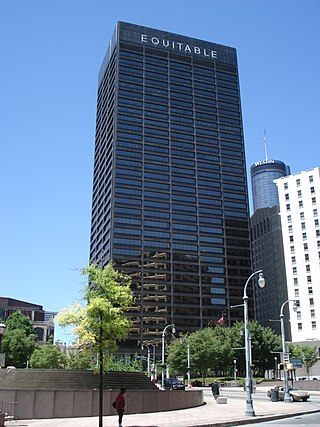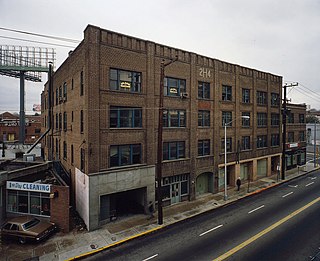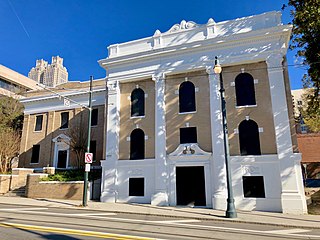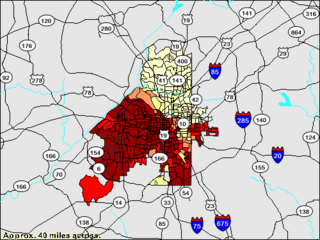
The Martin Luther King Jr. National Historical Park covers about 35 acres (0.14 km2) and includes several sites in Atlanta, Georgia related to the life and work of civil rights leader Martin Luther King Jr. Within the park is his boyhood home, and Ebenezer Baptist Church — the church where King was baptized and both he and his father, Martin Luther King Sr., were pastors — as well as, the grave site of King, Jr., and his wife, civil rights activist Coretta Scott King.

The Governor's Mansion is the official home of the governor of the U.S. state of Georgia. The mansion is located at 391 West Paces Ferry Road NW, in the Tuxedo Park neighborhood of the affluent Buckhead district of Atlanta.

The Sweet Auburn Historic District is a historic African-American neighborhood along and surrounding Auburn Avenue, east of downtown Atlanta, Georgia, United States. The name Sweet Auburn was coined by John Wesley Dobbs, referring to the "richest Negro street in the world," one of the largest concentrations of African-American businesses in the United States.

The Equitable Life Assurance Building is a 32-story, 453 foot tall office building in Atlanta, Georgia. It is located at 100 Peachtree Street in the Fairlie-Poplar neighborhood in downtown Atlanta. A typical example of an International-style skyscraper, the building was designed by Chicago-based architectural firm Skidmore, Owings and Merrill, and was constructed in 1968 on the site of the former Piedmont Hotel. The building's "EQUITABLE" signage was an easily recognizable piece of the downtown Atlanta skyline, while the tower's black finish stood in sharp contrast to the surrounding buildings. The building's signage was changed in late 2018 to now host a digital signage board for the new main tenants.

Alonzo Franklin Herndon was an African-American entrepreneur and businessman in Atlanta, Georgia. Born into slavery, he became one of the first African American millionaires in the United States, first achieving success by owning and operating three large barber shops in the city that served prominent white men. In 1905 he became the founder and president of what he built to be one of the United States' most well-known and successful African-American businesses, the Atlanta Family Life Insurance Company.
Washington Park is a historically black neighborhood in northwest Atlanta encompassing historic residential, commercial, and community landmark buildings. It is situated two miles (3 km) west of the central business district of Atlanta. The combination of gridiron and curvilinear streets is a result of the neighborhood having been developed from four separate subdivision plats. One of these plats created Atlanta's first planned black neighborhood, while the other three were abandoned by white developers and adopted by Heman Perry, an early 20th-century black developer. Although Perry did not receive a formal education past the seventh grade, in 1913 he founded one of the largest black-owned companies in the United States, the Standard Life Insurance Company of Atlanta.

The Odd Fellows Building and Auditorium, located at 228—250 Auburn Avenue, N.E. in the Sweet Auburn Historic District of Atlanta, Georgia, are historic buildings built in 1912 and 1913, respectively, as the headquarters of the District Grand Lodge No. 18, Jurisdiction of Georgia, of the Grand United Order of Odd Fellows in America. B.S. Ingram was District Grand Master and Dr. William F. Penn was chairman of the building committee. Renowned Atlanta-based architect William Augustus Edwards designed the buildings, while Robert E. Pharrow was the contractor and M.B. Morton was superintendent of construction. Booker T. Washington dedicated the Odd Fellows Building in 1912.

Adrienne Elizabeth McNeil Herndon (1869-1910) was an actress, professor, and activist in Atlanta, Georgia. While admittedly an African American to friends and colleagues, she performed with the stage name Anne Du Bignon. She was one of the first African American faculty at Atlanta University, where she met W. E. B. Du Bois and subsequently worked with him. Herndon and Alonzo Herndon were an influential couple.

The Herndon Building was a contributing property in the Sweet Auburn Historic District of Atlanta, Georgia, located across Auburn Avenue from the Odd Fellows Building and Auditorium.

Fountain Hall, formerly Fairchild Hall and Stone Hall, is a historic academic building on the grounds of Morris Brown College in Atlanta, Georgia. Built in 1882, it is the oldest surviving building originally associated with Atlanta University—now Clark Atlanta University—which is the first of all historically black colleges and universities in the American South founded September 19, 1865. It was declared a National Historic Landmark in 1974. It is now named after Bishop William A. Fountain.

The General Oliver Otis Howard House, also known as Howard Hall, is a historic house, and the oldest surviving building on the campus of Howard University, in Washington, D.C. Built in 1867, it was the home of General Oliver Otis Howard, the university founder and its third president. The house was declared a National Historic Landmark in 1974. It faces Georgia Avenue NW, just north of Howard Place.
Jesse Hill Jr. was an African American civil rights activist. He was active in the civic and business communities of the city for more than five decades. Hill was president and chief executive officer of the Atlanta Life Insurance Company, from 1973 to 1992, and was the first African American to be elected president of a chamber of commerce in a major city. During Hill's presidency of the Atlanta Life Insurance Company it became the largest black-owned life insurance company in the nation. He was a member of the board of directors for the 1996 Summer Olympics in Atlanta.
In 1994 the Atlanta Housing Authority, encouraged by the federal HOPE VI program, embarked on a policy created for the purpose of comprehensive revitalization of severely distressed public housing developments. These distressed public housing properties were replaced by mixed-income communities.

The Atlanta Life Financial Group was founded by Alonzo Herndon in Atlanta, Georgia. Born into slavery, he started in Atlanta as a young barber, eventually owning three shops. He became Atlanta's richest African American and a highly successful businessman. For many years, the life insurance company was one of the most prominent African-American businesses in the United States. The demolished public housing project Herndon Homes was named for Herndon.

English Avenue and Vine City are two adjacent and closely linked neighborhoods of Atlanta, Georgia. Together the neighborhoods make up neighborhood planning unit L. The two neighborhoods are frequently cited together in reference to shared problems and to shared redevelopment schemes and revitalization plans.

Black Atlantans form a major population group in the Atlanta metropolitan area, encompassing both those of African-American ancestry as well as those of recent Caribbean or African origin. Atlanta has long been known as a center of black wealth, higher education, political power and culture; a cradle of the Civil Rights Movement.

First Congregational Church is a United Church of Christ church located in downtown Atlanta at the corner of Courtland Street and John Wesley Dobbs Avenue. It is notable for being the favored church of the city's black elite including Alonzo Herndon and Andrew Young, for its famous minister Henry H. Proctor, and for President Taft having visited in 1898.
Ivenue Love-Stanley,, , is an American architect. She co-founded Stanley, Love-Stanley P.C., an Atlanta-based architecture and design firm. She was the first African-American woman to graduate from Georgia Institute of Technology's College of Architecture, and in 1983 she became the first African-American woman licensed architect in the Southeast. Love-Stanley's projects include the Aquatic Center for the 1996 Centennial Olympic Games, the Lyke House Catholic Student Center at the Atlanta University Center, the Southwest YMCA and St. Paul's Episcopal Church, the Auburn Market in Sweet Auburn and the National Black Arts Festival headquarters.
South-View Cemetery is a historic African-American-founded cemetery located approximately 15 minutes from downtown Atlanta, Georgia. An active operational cemetery on over 100 acres of land, it is the oldest African-American cemetery in Atlanta, Georgia and the oldest African-American “non eleemosynary” corporation in the country. Founded in 1886, it has since served as the burial place for many leaders in the civil rights movement including Julian Bond and John Lewis. Martin Luther King Jr. was originally buried here but was later moved to the King National Historic Park in Atlanta.
Norris Bumstead Herndon was a prominent African-American businessman, Harvard Business School MBA graduate, philanthropist, member of Alpha Phi Alpha fraternity, and second President of the historic African-American-owned Atlanta Life Insurance Company.

















